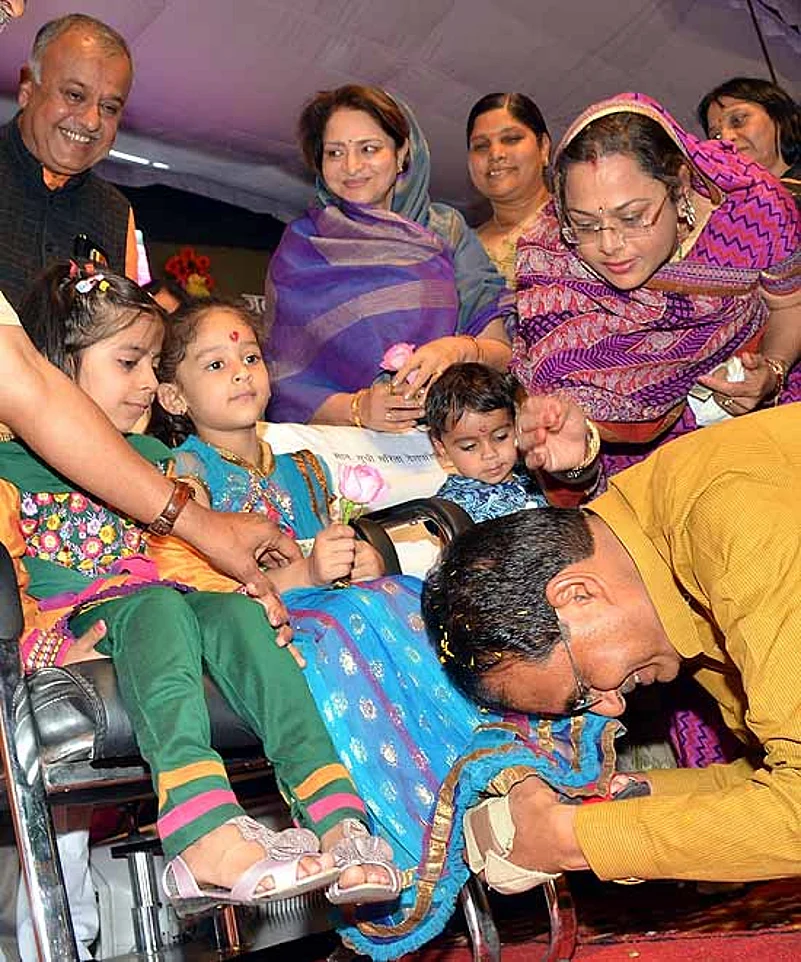The Dole Route
- Delhi Despite leading with schemes like Bhagidari, Congress lost due to poor implementation, corruption.
- Rajasthan Schemes like free medicine, right to time-bound services implemented. Political disconnect, delay failed to help.
- Mizoram CM Lalthanhawla rode to victory on a range of welfare schemes.
- Madhya Pradesh Welfare and empowerment through rights-based services model along with a strong dose of development helped CM Shivraj Chouhan win a third term.
- Chhattisgarh Chief minister Raman Singh continues to be identified by his welfare programmes. However his support base has slipped in the interiors for varied reasons.
***
One of the biggest ‘fights’ of 2013 was centred on economics—yes, growth versus development—with Jagdish Bhagwati and Amartya Sen playing the lead actors. Now, in the dying days of December, this much-reported debate between two academics (with books to sell) has a new edge. In the aftermath of the drubbing suffered by the UPA in the recent assembly elections, there is an attack on the UPA’s welfare-led policy, derisively dubbed ‘dole-nomics’ or ‘welfare-nomics’.
Some economists are now asking if welfare-nomics really translates into votes. This runs against perceived political wisdom: the last nine years of the UPA government has seen a number of welfare programmes being redesigned and many other rights-based schemes being introduced. In fact, a large part of the 2009 election victory of the Congress-led UPA government was attributed to NREGA, the farm loan waiver and the Sixth Pay Commission goodies.
Economist Surjit Bhalla disagrees. “Welfarism has not delivered votes historically since the mid-’80s,” he argues. “Now we have evidence that bad economics, even when perpetuated with welfarism, does not deliver votes,” he adds, arguing that “empirical evidence shows that economic performance and growth deliver votes, whether it is for Nitish Kumar in Bihar, Narendra Modi in Gujarat or Naveen Patnaik in Orissa”.
There are, of course, contrasting reactions to this attack. Biraj Patnaik, principal advisor to the commissioners of the Supreme Court on the Right to Food, says that, contrary to perceptions, the elections were all about welfare schemes triumphing. “It has completely worked in favour of two incumbent governments (Madhya Pradesh and Chhattisgarh),” says Patnaik. “My lesson is that welfarism works as it should. People want services and they want delivery. Food security will not work for them (UPA) as they will not be delivered on that promise.”
Food, in fact, drives the political context: this time around, the incumbent UPA government is banking on several schemes, including the redesigned subsidised food scheme under the Right to Food legislation and the targeted fund-transfer scheme using the Aadhaar platform. While the cash transfer has started in many states, with due hiccups, the benefits of the much-awaited and diluted food scheme will not be known before the 2014 elections.
What lessons can really be learnt from the recent assembly elections? “All the free-flowing cash doles are a populist move made ahead of assembly polls. This has never happened before and is a blatant misuse of the public funds,” was a strong statement that came from Vasundhararaje, Rajasthan’s new chief minister, when she was campaigning. Now that she’s in the saddle, it remains to be seen which of the many schemes rolled out by her predecessor in the last couple of years will be rolled back.
Nikhil Dey, a social activist based in Rajasthan, says deposed Rajasthan chief minister Ashok Gehlot had implemented many welfare schemes in areas that deeply affected people, whether it was free medical check-ups and medicines, pensions or subsidised bus fares for women. They may well have translated into votes for Gehlot, but for the lack of political messaging, late implementation of the schemes, and political infighting in the Congress state unit. “Vasundhara won’t be able to roll back any of the schemes as people recognise their benefits. She would have to improve on them,” says Dey.

Photograph by Sanjay Rawat
In fact, a common tactic adopted by both the winning incumbent governments of MP and Chhattisgarh was to enhance programmes originally chalked out by the Centre. Thus, under NREGA in MP, instead of 100 days’ employment, 150 days were offered. In Chhattisgarh, one month’s maternity benefit has been added for jobcard-holding women. The state also offers skill development as a right.
Says Govind Malu, a BJP leader and VC, Madhya Pradesh State Mining Corporation, “Welfare schemes should target the poor, but when it comes along with empowerment and development, it will pull more people out of poverty.” As the Madhya Pradesh government has found, welfare programmes are looked upon as part of government’s duties. Interestingly, in most states that went to the polls, the shortcoming of jobless growth has been laid at the door of the Centre. And, of course, the states are able to take credit for anything good, be it the Metro in Delhi, or better implementation of NREGA in Madhya Pradesh.
“Welfare needs to lead to empowerment and development,” says Amitabh Behar of Wada Na Todo, an umbrella of ngos looking into governance and delivery of government schemes. The real problem is poor implementation, particularly on the last-mile linkage. It is the huge gap in delivery that tends to make people lose faith in the government, as witnessed in Delhi, where the last few years have seen considerable investment in infrastructure.
But as Wada Na Todo’s annual assessment has revealed, whether it is rte, panchayati raj or NREGA, all suffer from lack of proper delivery, or inadequate resources. The outcome depends on local implementation, which differs and hence gives different results.
There are other issues, of course. Shashank Bhide of NCAER says the issue is not so much the subsidies and welfare, for which the states are able to take the credit. “Essentially, it is inflation, the lack of industrial growth and low employment generation that have had more influence,” says Bhide.
Similarly, just as outcomes of welfare schemes vary, there is no simple correlation between welfare schemes and votes. “Irrespective of whether you win or lose an election, welfare schemes have to go on. These are not doles. It is about empowerment and entitlement,” says Latika Dikshit Syed, a rural development consultant and Sheila Dikshit’s daughter. This context matters because, faced with the prospect of failing to contain its fiscal deficit, the UPA government has started to check spending.
Among schemes earmarked for a funds cut are the NREGA and the rural housing scheme, to which rural development minister Jairam Ramesh has objected. He has written to the prime minister, hinting at the political cost, saying such cuts would “send the wrong political signals” (see interview). Left unsaid is that cutting flagship schemes will cost the UPA votes.
Dr Narendar Pani of the National Institute of Advanced Studies, Bangalore, does not discount this fear. He says that just as governments vie with each other in laying out welfare schemes, people too have come to expect and to seek more freebies, whether it is cheaper rice or, as witnessed in Delhi, cut in power bills—a promise of both the Aam Aadmi Party and the BJP. During economic slowdown, the demand is more for jobs and empowerment rather than dole, says Pani.
Indeed, there is no surety whether welfare schemes bring governments votes, as seen in states like Tamil Nadu where both the major parties have for years been practising the politics of dole. What cannot be discounted is that Tamil Nadu has also seen a concerted development push, including job creation through major industrial hubs. Is there a message here for voters who seem to be looking beyond doles?


























